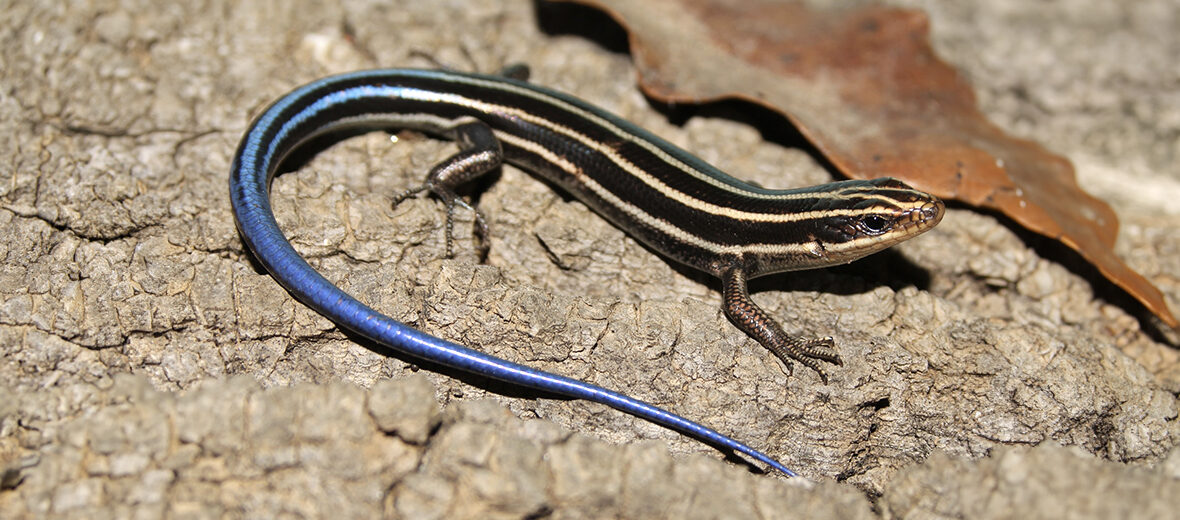
The five-lined skink, aka blue-tailed skink or red-headed skink, is among the most common lizards in the eastern United States, and is also a native of Canada. Sans some habitat loss, hunting, and trapping, these lizards don’t face many other threats. Their populations are stable across their range. The IUCN thus lists these lizards as Least Concern.
First the Stats…
Scientific name: Plestiodon fasciatus
Weight: Up to .5 ounce
Length: Up to 8.5 inches
Lifespan: Up to 6 years
Now on to the Facts!
1.) They are sometimes referred to as the American five-lined skink in order to tell them apart from the African five-lined skink.
2.) There are also western red-headed skinks, which are another species of skink as well.
3.) The formal blue-tailed skink (Cryptoblepharus egeriae) is from Christmas Island.
4.) Males are often larger than the females, however this depends on the area in which they live. This makes them sexually dimorphic.
5.) These lizards can be found throughout the eastern half of the United States and the eastern half of Canada, from the northern habitable parts of Canada down to the southern-most states of the U.S. They have also been documented in northern South America, in Colombia.
But wait, there’s more on the five-lined skink!
6.) Five-lined skinks are terrestrial (spend their lives on the ground.
7.) This lizard prefers moist, hardwood habitats and broken, rocky areas with permanent access to a water source like rivers or streams.
Did you know…?
The five-lined skink brumates (hibernation for reptiles) during the colder winter months.
8.) These lizards are diurnal (active during the day).
9.) Courting males grasp onto the necks of receptive females with their jaws after approaching them from the side. Using their tail to align cloacal openings, males initiate copulation by inserting 1 of the 2 hemipenes into the female’s cloaca. Copulation usually lasts 4 – 8 minutes.
10.) Males mate with multiple females.
But wait, there’s still more on the five-lined skink!
11.) Fertilization is internal and takes place starting in March, with eggs being laid from May – July.
12.) Females display high levels of parental care which helps reduce egg mortality. Females show several brooding positions of variant contact levels with their body placed over, beside, through, or in a coil around the eggs to protect them.
Did you know…?
They are capable of caudal autonomy (detaching all or part of their tail) in the event of a predator’s attack. They can also bite and musk (release a stinky substance from their anus).
13.) It is not uncommon for a clutch of eggs to come from multiple sires (males).
14.) The 15 – 18 eggs hatch in up to 55 days, based on the ambient temperature. The warmer the temperature, the shorter the incubation time.
15.) Crows, domestic cats, hawks, moles, opossums, raccoons, shrews, snakes, and skunks all prey on these lizards.
But wait, there’s still a little more on the five-lined skink!
16.) Beetles, crickets, spiders, and other insects make up their diet. However, frogs, other juvenile lizards, and even newborn mice are also sometimes preyed on.
17.) In captivity, they will also consume fruits and vegetables, typically served as a kind of smoothie or paste, of sorts.
18.) It is illegal to take any of the 3 species of skinks found in Canada from their natural habitats.
19.) Some U.S. states enforce general restrictions on removing reptiles including native five-lined skinks from the wild without a permit or hunting license. An example of this is in Maryland where no more than 4 may be possessed without a permit.
Now a Short Five-Lined Skink Video!
Be sure to share & comment below! Also, check out the Critter Science YouTube channel. Videos added regularly!
Want to suggest a critter for me to write about? Let me know here.
Some source material acquired from: Wikipedia & IUCN
Photo credit: iNaturalist




